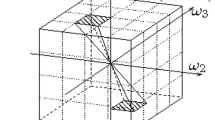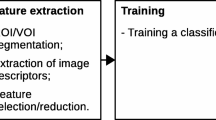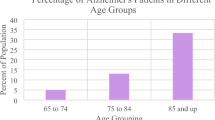Abstract
In this paper we present an automated method for diagnosing Alzheimer disease (AD) from brain MR images. The approach uses the scale-invariant feature transforms (SIFT) extracted from different slices in MR images for both healthy subjects and subjects with Alzheimer disease. These features are then clustered in a group of features which they can be used to transform a full 3-dimensional image from a subject to a histogram of these features. A feature selection strategy was used to select those bins from these histograms that contribute most in classifying the two groups. This was done by ranking the features using the Fisher’s discriminant ratio and a feature subset selection strategy using the genetic algorithm. These selected bins of the histograms are then used for the classification of healthy/patient subjects from MR images. Support vector machines with different kernels were applied to the data for the discrimination of the two groups, namely healthy subjects and patients diagnosed by AD. The results indicate that the proposed method can be used for diagnose of AD from MR images with the accuracy of %86 for the subjects aged from 60 to 80 years old and with mild AD.



Similar content being viewed by others
References
Villain, N., Desgranges, B., Viader, F., De la Sayettte, V., Mezenge, F., Landeau, B., Baron, J.-C., Eustache, F., and Chetelat, G., Relationships between Hippocampal Atrophy, White Matter Disruption, and Grey Matter Hypometabolism in Alzheimer’s disease. J Neurosci 28(24):6174–6181, 2008.
Qiu, A., Fennema-Notestine, C., Dale, A. M., and Miller, M. I., Regional shape abnormalities in mild cognitive impairment and Alzheimer’s Disease. Neuroimage 45(3):656–661, 2009.
Ishii, K., Kawachi, T., Sasaki, H., Kono, A. K., Fukuda, T., Kojima, Y., and Mori, E., Voxel-based morphometric comparison between early- and late-onset mild Alzheimer’ disease and assessment of diagnostic performance of Z score images. Am J Neuroradiol 26:333–340, 2005.
Toews, M., Wells, W. M., Collins, D. L., and Arbel, T., Feature-based morphometry: discovering group-related anatomical patterns. Neuroimage 49(3):2318–2327, 2010.
Harris, C., Stephens, M., A combined corner and edge detector. In: Proceedings of the 4th Alvey Vision Conference. pp. 147–151, 1988.
Rohr, K., On 3D differential operators for detecting point landmarks. Image Vis Comput 15(3):219–233, 1997.
Lowe, D. G., Distinctive image features from scale-invariant keypoints. Int J Comput Vis 60(2):91–110, 2004.
MacKay, D., Information theory, inference and learning algorithms. Cambridge University Press, 2003.
Duda, R. O., Hart, P. E., Stork, D. G., Pattern classification. John Wiley & Sons, 2001.
Theodoridis, S., Koutroumbas, K., Pattern recognition, 4th Edition. Academic Press, 2009.
Webb, A. R., Statistical pattern recognition, 2nd Edition. John Wiley & Sons, 2002.
Goldberg, D. E., Genetic algorithms in search, optimization, and machine learning. Addison-Wesley, 1989.
Burges, C. J. C., A tutorial on support vector machines for pattern recognition. Data Min Knowl Discov 2:121–167, 1998.
Vapnik, V. N., The nature of statistical learning theory. Springer, 1995.
Hsu, C.-W., and Lin, C.-J., A comparison of methods for multiclass support vector machines. IEEE Trans Neural Netw 13(2):415–425, 2002.
Marcus, D., Wang, T., Parker, J., Csernansky, J., Morris, J., and Buckner, R., Open access series of imaging studies (oasis): Cross-sectional MRI data in young, Middle aged, nondemented and demented older adults. J Cogn Neurosci 19:1498–1507, 2007.
Talairach, J., and Tournoux, P., Co-planar stereotaxic atlas of the human brain. Thieme, New York, 1988.
Buckner, R., Head, D., Parker, J., Fotenos, A., Marcus, D., Morris, J., and Snyder, A., A unified approach for morphometric and functional data analysis in young, old, and demented adults using automated Atlas-based head size normalization: reliability and validation against manual measurement of total intracranial volume. Neuroimage 23:724–738, 2004.
Evgeniou, T., Pontil, M., and Elisseeff, A., Leave one out error, stability, and generalization of voting combinations of classifiers. J Mach Learn 55(1):71–97, 2004.
Author information
Authors and Affiliations
Corresponding author
Rights and permissions
About this article
Cite this article
Daliri, M.R. Automated Diagnosis of Alzheimer Disease using the Scale-Invariant Feature Transforms in Magnetic Resonance Images. J Med Syst 36, 995–1000 (2012). https://doi.org/10.1007/s10916-011-9738-6
Received:
Accepted:
Published:
Issue Date:
DOI: https://doi.org/10.1007/s10916-011-9738-6




